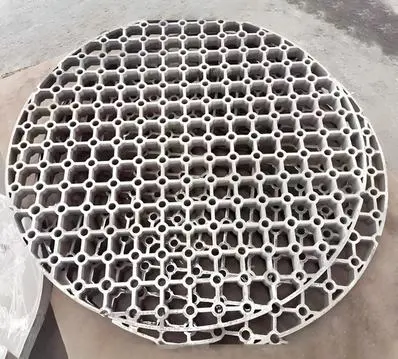The Role of Base Trays in Industrial Safety
Thermal Insulation Properties
Base trays are engineered with advanced materials that possess exceptional thermal insulation properties. These materials, such as high-grade ceramics or refractory alloys, create a formidable barrier against heat transfer. By effectively containing and dissipating heat, base trays prevent the spread of high temperatures to surrounding areas, significantly reducing the risk of accidental burns and equipment damage. This thermal insulation capability is particularly crucial in industries like metallurgy and aerospace, where extreme temperatures are routinely encountered during manufacturing processes.
Structural Integrity Under Heat Stress
One of the key attributes of high-quality base trays is their ability to maintain structural integrity under intense heat stress. These components are designed to resist warping, cracking, or deformation even when exposed to temperatures that would compromise ordinary materials. This resilience ensures that the base tray continues to provide a stable and level surface for equipment and materials throughout high-temperature treatments. In industries such as oil and gas, where precision and stability are paramount, the unwavering support offered by base trays contributes significantly to operational safety and efficiency.
Containment of Hazardous Materials
Base trays serve a critical function in containing potentially hazardous materials during high-temperature processes. In industries like chemical manufacturing or nuclear power generation, where the handling of corrosive or radioactive substances is necessary, base trays act as a first line of defense against spills and leaks. Their design often incorporates raised edges or specialized containment features that prevent the spread of dangerous materials, even if they become molten or volatile due to extreme heat. This containment capability is essential for preventing environmental contamination and protecting workers from exposure to harmful substances.
Design Features That Enhance Safety
Heat-Resistant Coatings and Finishes
Advanced base trays often feature specialized coatings and finishes that further enhance their heat-resistant properties. These surface treatments can include ceramic glazes, high-temperature paints, or innovative nanocoatings that provide an additional layer of thermal protection. Such coatings not only improve the tray's ability to withstand extreme temperatures but also extend its lifespan by reducing wear and corrosion. In aerospace applications, where components are subjected to rapid temperature changes, these coatings play a crucial role in maintaining the integrity of the base tray and the safety of the overall system.
Ergonomic Handling Features
Safety during high-temperature treatments extends beyond the thermal properties of base trays to include their handling characteristics. Modern base tray designs often incorporate ergonomic features such as reinforced handles, balanced weight distribution, and non-slip surfaces. These elements reduce the risk of accidents during transportation and positioning of the trays, especially when they are carrying hot materials or equipment. In industries like automotive manufacturing, where rapid and precise handling of heated components is essential, these ergonomic features contribute significantly to worker safety and operational efficiency.
Integrated Monitoring Systems
Cutting-edge base trays may include integrated monitoring systems that provide real-time data on temperature, pressure, and other critical parameters. These smart features allow operators to closely monitor conditions within the tray, enabling early detection of potential safety issues. For instance, in the medical equipment industry, where precise temperature control is crucial for sterilization processes, such monitoring capabilities ensure that safety protocols are consistently maintained. By providing instant feedback, these systems empower workers to make informed decisions, further enhancing the overall safety of high-temperature treatments.
Applications Across Various Industries
Oil and Gas Sector
In the oil and gas industry, base trays play a vital role in ensuring safety during high-temperature operations such as refining and petrochemical processing. These trays are often used to support catalytic reactors, heat exchangers, and other critical equipment that operate at extreme temperatures. The robust construction of base trays helps prevent equipment failure and contains potential spills, reducing the risk of fires and environmental contamination. Additionally, their heat-resistant properties protect workers from burn hazards and help maintain the structural integrity of surrounding infrastructure.
Metallurgical and Mining Machinery
The metallurgical and mining sectors rely heavily on base trays for safe handling of molten metals and hot ore samples. During smelting and refining processes, these trays provide a stable platform for crucibles and molds, ensuring that hot materials are securely contained. The high thermal capacity of specialized base trays allows for gradual cooling of metal specimens, preventing thermal shock and reducing the risk of splattering or unexpected material behavior. In mining operations, heat-resistant base trays are essential for safely transporting and analyzing hot rock samples, contributing to both worker safety and accurate mineral assessment.
Aerospace Manufacturing
Aerospace manufacturing involves numerous high-temperature processes, from heat treating aircraft components to testing rocket engine parts. Base trays designed for this industry often incorporate advanced composite materials that offer exceptional heat resistance while remaining lightweight. These trays are crucial for safely moving hot components between different stages of production, such as from furnaces to inspection areas. The precision engineering of aerospace-grade base trays ensures that delicate parts maintain their shape and integrity during thermal cycling, directly impacting the safety and reliability of the final aircraft or spacecraft.
In conclusion, base trays are indispensable components that significantly enhance safety during high-temperature treatments across a wide range of industries. Their advanced design features, including thermal insulation, structural integrity, and containment capabilities, make them essential for protecting workers, equipment, and the environment. As industrial processes continue to push the boundaries of temperature extremes, the role of base trays in maintaining safety standards becomes increasingly critical. For more information on how base trays can improve safety in your specific industrial application, please contact us at info@welongpost.com.




